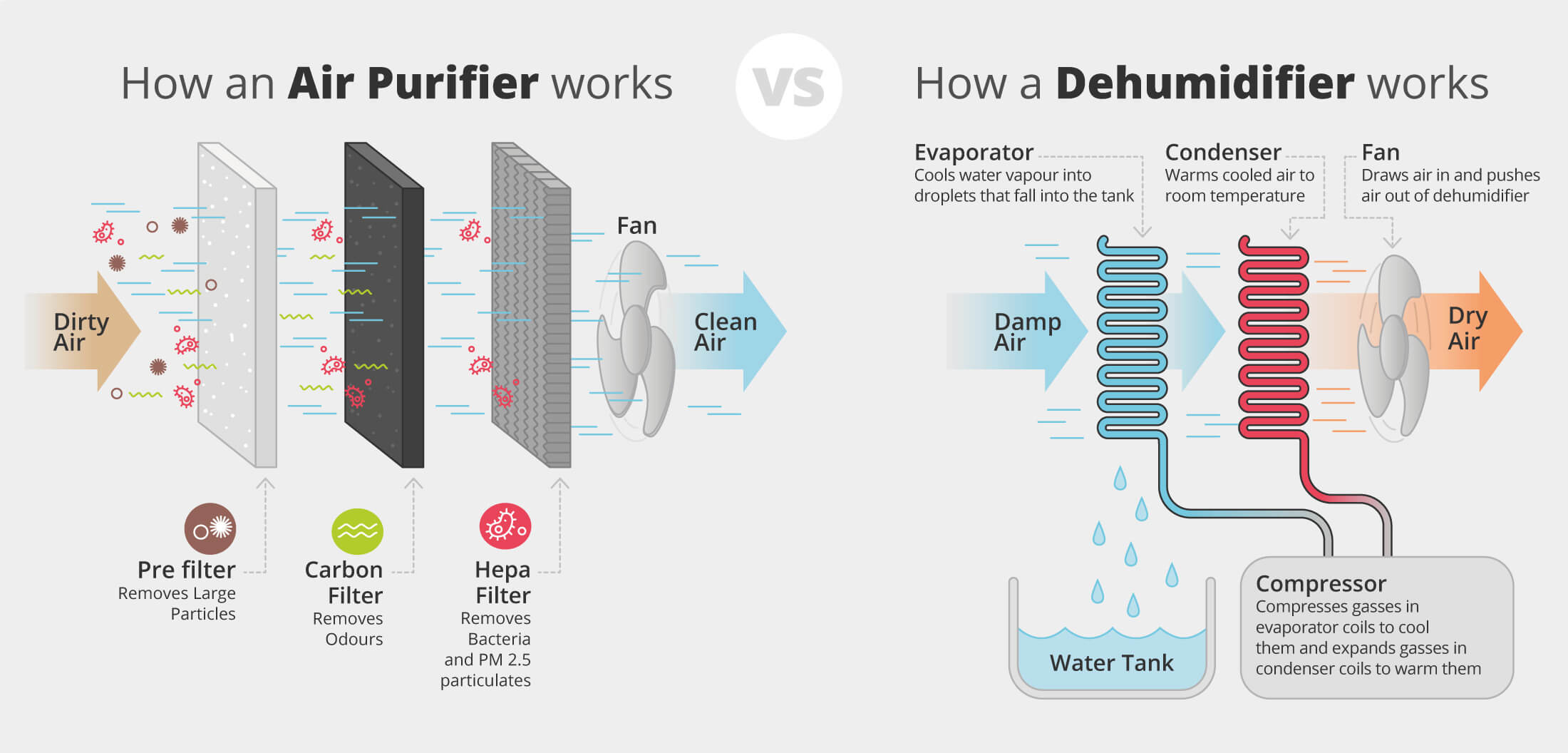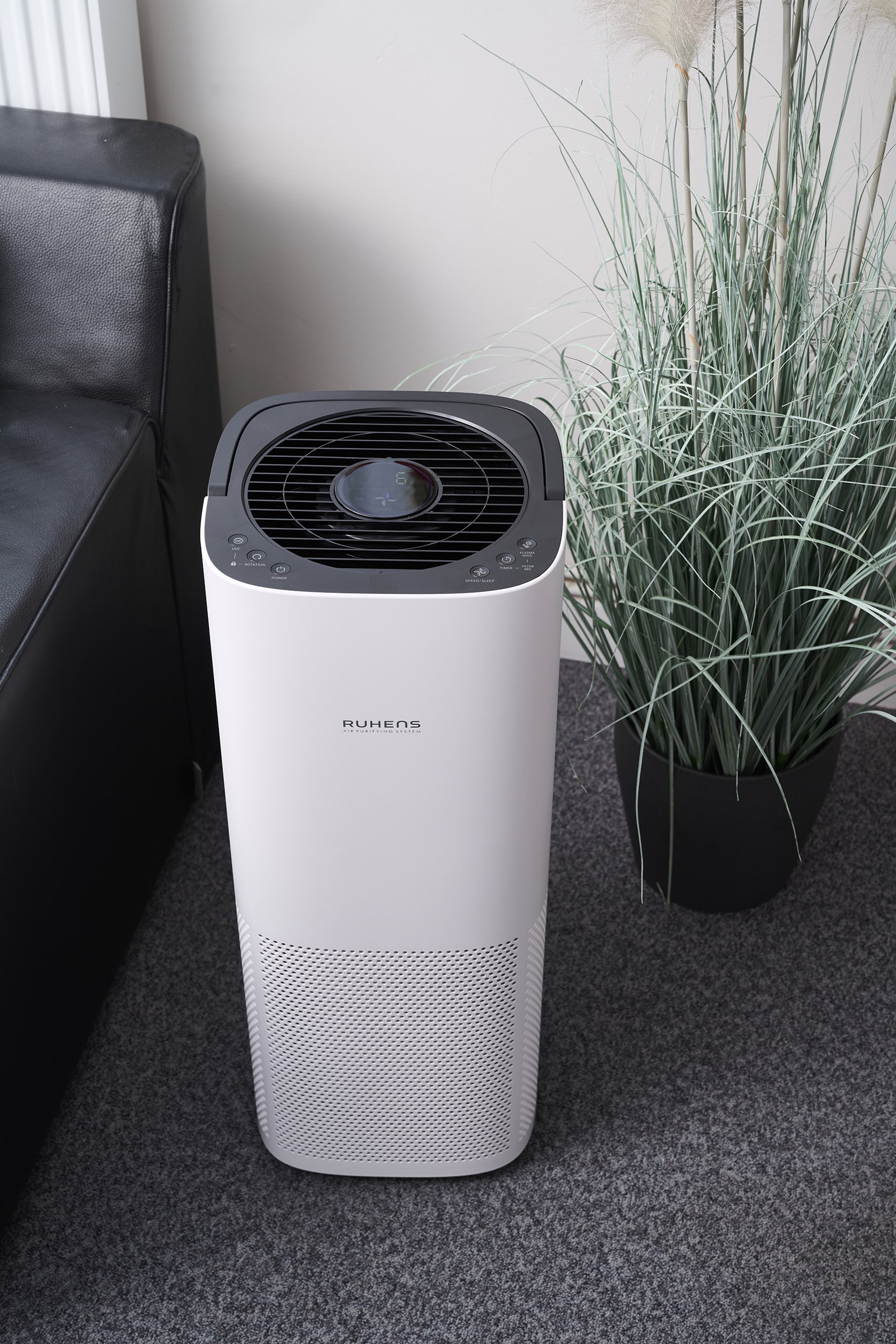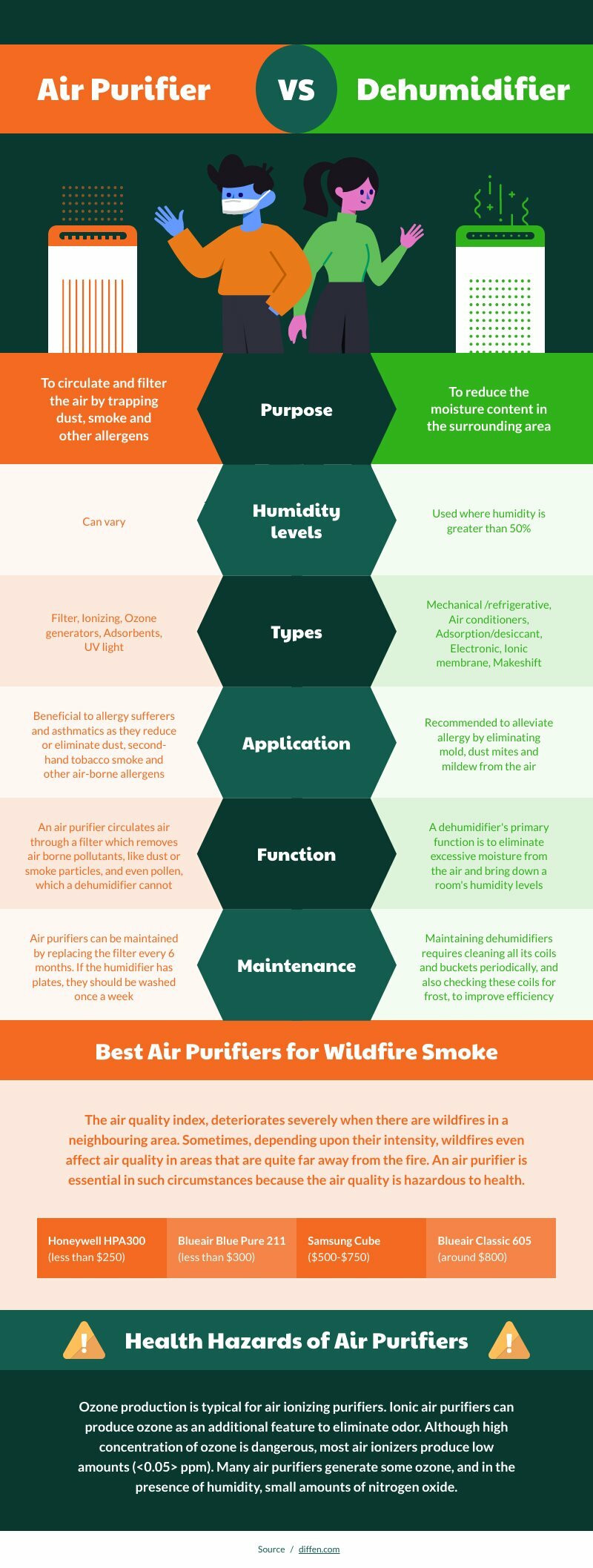In a world where indoor air quality has become a growing concern, it’s important to understand the difference between dehumidifiers and air purifiers. These two devices may seem similar at first glance, but they serve distinct purposes in improving the air you breathe. While dehumidifiers target excess moisture in the air, air purifiers work to remove pollutants and allergens. So, whether you’re grappling with mold and dampness or suffering from allergies, it’s crucial to know which device will best suit your needs. Let’s dive into the fascinating world of dehumidifiers and air purifiers to find out what you need to know.

Benefits of Dehumidifiers
Reduced risk of mold and mildew growth
One of the primary benefits of using a dehumidifier in your home is the reduced risk of mold and mildew growth. High levels of humidity can create the perfect environment for mold spores to thrive, which can pose serious health risks and damage your property. By removing excess moisture from the air, dehumidifiers help to prevent the growth of mold and mildew, creating a healthier and safer living environment for you and your family.
Alleviation of allergy and asthma symptoms
If you or someone in your household suffers from allergies or asthma, a dehumidifier can provide significant relief. Mold, dust mites, and other allergens thrive in humid conditions, exacerbating respiratory symptoms. By maintaining optimal humidity levels, dehumidifiers reduce the presence of these irritants in the air, helping to alleviate allergy and asthma symptoms. Breathing cleaner, drier air can make a noticeable difference in your overall respiratory health and quality of life.
Protection for wooden furniture and flooring
Excessive moisture in the air can wreak havoc on your wooden furniture and flooring. High humidity levels can cause wooden materials to absorb moisture and expand, leading to warping, cracking, and deterioration over time. By maintaining the ideal humidity level in your home, dehumidifiers help to protect your valuable wooden investments, ensuring their longevity and preserving their beauty.
Benefits of Air Purifiers
Removal of airborne pollutants
One of the key benefits of using an air purifier is the removal of airborne pollutants. Indoor air often contains a variety of contaminants such as dust, pet dander, pollen, and even harmful chemicals from cleaning products. These pollutants can contribute to respiratory issues, allergies, and other health problems. Air purifiers work by filtering and trapping these airborne particles, improving the overall air quality in your home and creating a cleaner and healthier environment for you and your loved ones.
Improved indoor air quality
Air purifiers play a crucial role in improving indoor air quality. In addition to removing allergens and pollutants, they can also help eliminate unpleasant odors, smoke, and volatile organic compounds (VOCs) that may be present in your home. By continuously circulating and filtering the air, air purifiers help to eliminate impurities, creating a fresh and clean atmosphere within your living space.
Enhanced respiratory health
Breathing in clean air is essential for maintaining optimal respiratory health. Air purifiers can significantly reduce the presence of airborne irritants, such as dust, pet allergens, and pollen, which are known triggers for respiratory conditions like asthma and allergies. By providing cleaner air to breathe, air purifiers can help prevent respiratory symptoms and improve your overall lung health.
Differences in Function
Dehumidifiers target and reduce humidity levels in the air
Dehumidifiers are specifically designed to target and reduce humidity levels in the air. They work by extracting excess moisture from the environment, effectively lowering the overall humidity in a given space. Dehumidifiers achieve this by pulling in the moist air, cooling it to condense the moisture, and then releasing drier air back into the room. This process helps to prevent the growth of mold and mildew, and promotes a more comfortable and healthy living environment.
Air purifiers filter and remove airborne contaminants
While dehumidifiers focus on reducing humidity, air purifiers are designed to filter and remove airborne contaminants from the air you breathe. They use various types of filters, such as HEPA (High-Efficiency Particulate Air) filters, activated carbon filters, and electrostatic precipitators, to capture and trap particles, allergens, and other pollutants present in indoor air. By continuously cycling and purifying the air, air purifiers help to maintain cleaner and healthier indoor air quality.
Common Features of Dehumidifiers and Air Purifiers
Adjustable settings for humidity and air purification levels
Both dehumidifiers and air purifiers often come with adjustable settings that allow you to control the humidity levels and air purification effectiveness. These settings can be tailored to meet your specific needs, whether you need a higher dehumidification level during particularly humid seasons or a more intense air purification level to address specific air quality concerns.
Automatic shut-off and restart functionality
To maximize convenience and energy efficiency, many dehumidifiers and air purifiers feature automatic shut-off and restart functionality. This means that once the desired humidity or air purification level is reached, the device will automatically shut off to conserve energy. When the humidity or air quality starts to deteriorate again, the device will restart without any manual intervention.
Portability and ease of use
Both dehumidifiers and air purifiers are often designed to be portable and easy to use. They can be moved from room to room as needed, allowing you to target specific areas of your home where excess humidity or air pollutants are a concern. Additionally, most models are designed with user-friendly controls, intuitive interfaces, and easy maintenance features to make their operation hassle-free.

Suitable Applications for Dehumidifiers
Damp basements or crawl spaces
Dehumidifiers are especially beneficial in damp basements or crawl spaces where moisture tends to accumulate. These areas are prone to high humidity levels, which can lead to musty odors, mold growth, and damage to stored items. By effectively reducing the moisture content in these spaces, dehumidifiers can help prevent mold and mildew issues, minimize odors, and protect the structural integrity of your home.
High humidity areas
Any area of your home or workplace with high humidity levels can greatly benefit from the use of dehumidifiers. This includes rooms with poor ventilation, bathrooms, laundry rooms, or kitchens, where steam and moisture from showers, cooking, and drying clothes can contribute to excessive humidity. Dehumidifiers can effectively control and maintain the desired level of humidity in these areas, preventing the growth of mold, reducing musty odors, and promoting a more comfortable environment.
Wet laundry rooms or bathrooms
Laundry rooms and bathrooms are often sources of increased humidity due to activities like washing clothes, taking hot showers, and running water. Without proper ventilation, this moisture can linger in the air, leading to mold growth, musty odors, and even structural damage. Dehumidifiers can help to remove excess moisture from these spaces, preventing issues caused by high humidity and maintaining a dryer and healthier environment.
Suitable Applications for Air Purifiers
Allergen-prone households
For households with individuals who suffer from allergies or sensitivities to airborne allergens, air purifiers are an excellent addition. Air purifiers effectively filter out allergens such as dust mites, pet dander, pollen, and mold spores, providing relief to allergy sufferers and reducing the frequency and severity of allergic reactions. By continuously cleaning and purifying the air, air purifiers create a safe haven for those prone to allergies, allowing them to breathe easier and enjoy a healthier living environment.
Pet owners or households with fur-bearing animals
Pets are wonderful companions, but their presence can also introduce allergens and odors into your home. Air purifiers equipped with efficient filters can help reduce pet-related allergens, including pet hair, dander, and saliva particles, as well as eliminate pet odors. By capturing and removing these airborne pollutants, air purifiers create cleaner and fresher air, making your living space more comfortable for both you and your furry friends.
Urban environments with high outdoor pollution
Living in urban areas often means exposure to higher levels of outdoor pollution, which can find its way indoors. Airborne pollutants such as smog, fine particulate matter, and volatile organic compounds (VOCs) can have negative health effects when inhaled over time. Air purifiers, especially those with robust filtration systems, can effectively remove these harmful pollutants from the air, reducing your exposure and improving your overall indoor air quality.

Cost Considerations
Initial purchase cost
When considering the cost of dehumidifiers and air purifiers, it’s important to factor in the initial purchase cost. Prices can vary depending on the size, features, and brand of the device. While some entry-level models may be more affordable, devices with advanced features or larger coverage areas may come at a higher price point. It’s important to assess your needs and budget when determining which option is the best fit for your situation.
Operating costs
In addition to the initial purchase cost, it’s crucial to consider the ongoing operating costs associated with dehumidifiers and air purifiers. Both devices require electricity to operate, which will contribute to your monthly utility bills. Dehumidifiers also consume some energy to cool and condense the moisture in the air. Additionally, certain models of air purifiers may require filter replacement over time, adding to the long-term operational costs. It’s essential to take these factors into account when evaluating the overall cost-effectiveness of each device.
Maintenance expenses
Maintenance expenses should also be considered when comparing dehumidifiers and air purifiers. Dehumidifiers often require regular cleaning to prevent the buildup of dirt, dust, or mold on internal components and filters. Some models may have removable and washable filters, while others may require replacement filters, which will add to the maintenance costs. Air purifiers generally require filter replacements periodically to maintain their optimum performance. It’s important to factor in these ongoing maintenance costs when making your decision.
Energy Efficiency
Energy consumption levels
When choosing between a dehumidifier and an air purifier, it’s worth considering the energy consumption levels of each device. Dehumidifiers generally consume more energy, especially when running in high humidity conditions or larger areas. The cooling process used by dehumidifiers to extract moisture from the air requires more energy compared to the filtration process of air purifiers. It’s advisable to look for energy-efficient models that have earned an Energy Star rating, as they are designed to operate more efficiently and save energy.
Impact on utility bills
Given that both dehumidifiers and air purifiers consume energy, their operation will have an impact on your utility bills. The extent of this impact will depend on factors such as the device’s energy efficiency, the duration and frequency of use, and the specific settings selected. While dehumidifiers may contribute more to energy consumption due to their cooling mechanisms, the energy usage of air purifiers is typically lower. It’s advisable to assess your energy requirements and budgetary constraints to find a balance between device effectiveness and energy cost.

Noise Levels
dB ratings of dehumidifiers and air purifiers
Noise level can be an important consideration, especially if you plan to use your dehumidifier or air purifier in frequently occupied areas, such as bedrooms or living rooms. Both dehumidifiers and air purifiers produce some level of noise during operation, although the extent can vary depending on the model and fan speed settings. It’s helpful to look for devices with lower decibel (dB) ratings, as they will operate more quietly and ensure minimal disruption to your daily activities and sleep.
Considerations for noise-sensitive areas
In noise-sensitive areas such as offices, nurseries, or healthcare facilities, it’s essential to select dehumidifiers or air purifiers that operate silently or produce noise levels within acceptable limits. Some advanced models may have special features like “silent mode” or “night mode,” which minimize noise output while maintaining efficient performance. When noise is a concern, it’s recommended to research and compare the noise levels of different models and select one that offers the quietest operation without compromising on functionality.
Choosing the Right Device
Identifying specific needs and concerns
When deciding between a dehumidifier and an air purifier, it’s crucial to consider your specific needs and concerns. Assess factors such as the prevailing humidity levels in your area, the presence of mold or allergens, and any respiratory conditions you or your family members may have. If your primary concern is excessive moisture and the prevention of mold growth, a dehumidifier is likely the better choice. On the other hand, if you are more concerned about improving overall indoor air quality and reducing allergens, an air purifier may be the preferred option.
Considering room size and square footage
The size of the room or area where you plan to use the device is another critical factor to consider. Dehumidifiers and air purifiers come in various sizes and capacities, each designed to effectively operate within a specific square footage range. It’s important to measure the dimensions of the room and select a device that can adequately cover the desired area. Using an undersized device may result in insufficient dehumidification or purification performance, while an oversized device may lead to unnecessary energy consumption.
Seeking professional advice if necessary
If you find it challenging to determine which device is best for your specific situation or have unique requirements, seeking professional advice can be beneficial. Consulting with a qualified HVAC technician, an indoor air quality specialist, or a knowledgeable salesperson can provide you with expert guidance and recommendations tailored to your needs. These professionals can assess your environment, understand your concerns, and offer valuable insights to help you make an informed decision.
In conclusion, both dehumidifiers and air purifiers bring numerous benefits to your home or workplace. Dehumidifiers reduce the risk of mold growth, alleviate allergy symptoms, and protect wooden furniture and flooring. Air purifiers remove airborne pollutants, improve indoor air quality, and enhance respiratory health. Understanding the differences in their functions and considering factors such as room size, cost, energy efficiency, noise levels, and specific needs will help you choose the right device for your unique situation. Whether you require moisture control or air purification, both dehumidifiers and air purifiers are valuable tools in creating a healthier and more comfortable living environment.


Hi, I’m Cohan, the author behind Your Dehumidifier Guide, a website dedicated to helping you create a healthier and more comfortable living environment. With a tagline of “Breathe Easy, Live Better,” my ultimate goal is to provide you with the best dehumidification solutions for your home. Whether you’re looking for the perfect dehumidifier for your bathroom, small room, or basement, I’ve got you covered. Through in-depth reviews and comprehensive buying guides, I aim to equip you with the knowledge to tackle high humidity levels, prevent mold growth, and improve your indoor air quality. Trust me to be your ultimate guide in the world of dehumidifiers.